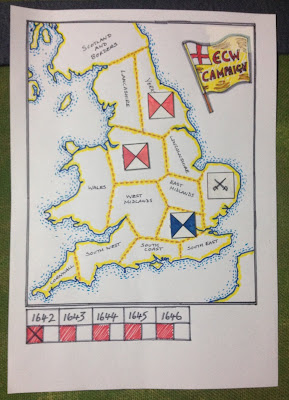 |
| The opening campaign move |
Order of battle
Parliamentarian forces:
1 x lobster unit
3 x trotter cavalry units
4 x infantry units (mixed pike and musket)
1 x commanded shot
Royalist forces:
4 x galloper cavalry units
4 x infantry units (mixed pike and musket)
1 x elite pike unit
2 x dragoon units
1 x commanded shot unit
1 x artillery unit
The method for deciding the composition of forces is described in a previous post. Because there is a Royalist controlled region adjacent to the Yorkshire region, they were able to re-roll a single dice roll and improve their chances of a large force.
 |
| Starting positions (Royalists in red and Parliament in blue) |
 |
| Starting positions |
 |
| The cavalry engagement begins. |
 |
| Royalist cavalry charge. |
With their left flank threatened the Parliamentarian commander moved his lobster unit held in reserve to counter the Royalist threat. The Royalist cavalry attack was nullified, but at the cost of the remaining Parliamentarian reserves. The Parliamentarian left flank was now open and Royalist dragoons moved forward along with their centre. The Parliamentarian commander saw his army's situation was untenable and retired.
 |
| Parliamentarian forces move to counter the threat to their flank |
 |
| Parliamentarian forces with an exposed flank and outnumbered retire and victory goes to Royalist forces |
 |
| The flow of the game |
 |
| Campaign situation |
That was a quick victory for the King!
ReplyDeleteYour maps and gaming table look superb, Peter. Well done!
Thank you. The maps are quite fun to draw, as to whether I draw one for each game, I am not sure yet.
DeleteA nice sharp action for openers, I shall enjoy following this
ReplyDeleteThanks, I enjoyed playing through the game. The opening campaign games of 1642 (of which there will be 11) to control the regions will all be geared to smaller actions.
DeleteAnnnnnd they'rrrrre OFF! Good start! A very attractive game.
ReplyDeleteLoL. Thank you, I am really looking forward to playing through these games.
DeleteGood to see the campaign season has begun. I shall follow developments with interest, hoping for a Parliamentary victory!
ReplyDeleteIt will be interesting to see if history repeats itself in this campaign.
DeleteHi Peter,
ReplyDeleteGreat campaign ideas here. Well done once again!
Cheers
Jay
Thanks Jay. I hope to get 15 to 20 games out of this campaign.
DeleteI picked up The English Civil War by David Clark today. Published by Pocket Essentials, and set as an overview of the war, I thought it might make an interesting primer to help me visualise your manoeuvres, recruitments etc. Oh, and it’s less than 150 pages :-)
ReplyDeleteI do like compact history books for idea as I am not a great reader of books. For the second part of the campaign 1643 onwards I will be having chance cards as the marching armies try to recapture regions.
DeleteHow do you set up the actual battles once you have determined the forces?
ReplyDeleteTerrain is written on cards and 6 features (cards) selected. The table is divided into six 2x2 foot square sections. One terrain feature (card) is placed in a section. The exception being rivers which go side to side and dice are used to determine where on a side its starts/finishes.
DeleteThe defender picks the tabletop side to defend and places their forces. The attacker (who made the campaign move) then places their forces. The defender can then reposition D3 units.
Thanks - that's very helpful
Delete